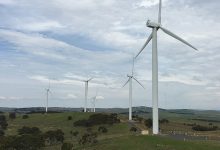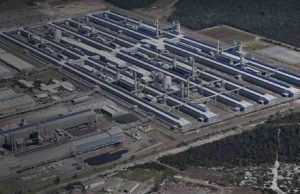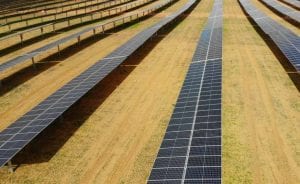The Australian Energy Regulator has begun court proceedings against four of Australia’s largest wind farm companies over the role of wind farms in the 2016 South Australian blackout that left 850,000 homes and businesses without power as the entire state experienced a “system black”.
The AER said in a statement on Wednesday that it has commenced proceedings in the Federal Court against AGL Energy, Neoen Australia, Pacific Hydro and Tilt Renewables, in connection to the wind farms the companies operate in South Australia.
The court action by the regulator – which will be fought by the wind companies involved – could lead to a more widespread “class action” from people and parties affected by the blackout which could then lead to significant claims if it succeeds.
The regulator’s action has already re-ignited the furious political debate around the performance of wind farms, and raised questions as to why the regulator has not sued the fossil fuel generators and the “black-start” installations that failed to work as required.
Privately, some have branded this action as a “witch-hunt.” Some suggest the logical conclusion of this is that coal generators that have adjusted their settings, or which fail at critical moments and lead to load-shedding, should also be a target.
As RenewEconomy revealed last September, the potential court action had been flagged by Neoen, which disclosed in its prospectus that action from the regulator was possible and could lead to a broader class action should it succeed. Neoen said at the time it would defend any such claims, but warned the legal battle could be drawn out and expensive.
When the AER report came out in December, when it also attributed multiple errors by the Australian Energy Market Operator, it said it did not intend to take any court action.
RenewEconomy understands the decision to issue court action followed further investigation of issues around the actual event that were not included in the December report. But these new investigations will not be released.
 The decision to take action against the wind farms, and not the fossil fuel generators that were supposed to provide “black start” capabilities but failed, extending the length of the blackout, has shocked many in the industry.
The decision to take action against the wind farms, and not the fossil fuel generators that were supposed to provide “black start” capabilities but failed, extending the length of the blackout, has shocked many in the industry.
In its statement on Wednesday, the AER says the companies cited in its case carry some responsibility for the cause and scale of the 2016 South Australian blackout, due to a failure by the companies to ensure the wind farms had sufficient protections and ‘ride-through’ capabilities during system interruptions.
It says these breached their generator performance standards and also the National Electricity Rules.
The wind farm operators are expected to argue that the rules were in no way clear, and there were differing views, even within energy institutions, about the benefits of multiple ride-through settings. In some cases, they may cause more problems than they solve.
The 2016 South Australian blackout was triggered by a severe storm that hit the State on September 28, 2016. The storm caused the failure of multiple transmission lines that caused voltage disturbances throughout the South Australian grid, that caused a snowball effect leading to the entire state losing power.
The voltage disturbances triggered protection systems within several South Australian wind farms, causing them to shut down. In its investigation of the event, AEMO found that these protection systems were set to more sensitive settings than it was aware of.
The loss of power from the wind farms caused further disruptions, including an overloading of the Haywood interconnector between South Australia and Victoria, which,. controversially, was running at full capacity at the time.
When the interconnector then failed, the entire state was plunged into blackout. Criticism has been levelled at AEMO about why it took no precautionary measures in the lead up to the storms, such as reducing the load on the interconnector and giving advanced warning to generators.
The regulator itself said in its report issued last December that AEMO made multiple errors in the lead up to the blackout, although it said it was not to blame.
Investigations have found multiple contributing factors to blackout, including a failure of other generators in South Australia to respond to the drop in supply, and substantial damage to network infrastructure from the storm itself, which caused a recorded 263 lightning strikes in the 5 minute window leading up to the blackout, and tornadoes in the vicinity of failed transmission lines.
It should be noted that the reports from both AEMO and the AER said it was not the nature of wind energy that was the issue, but the settings of the wind farms which have now been corrected.
That, however, will count for little in the likely political and media debate, given the hostility of the Coalition government and the Murdoch and other conservative media to wind energy in particular and renewables in general.
Sure enough, energy minister Angus Taylor, who has campaigned vigorously against wind farms since before he entered parliament, said he welcomed the court action and said the wind farms “weren’t generating as they should have”.
“People are going to bring wind and solar farms into the system, that’s fine, but they have to be properly integrated,” Taylor told reporters in Sydney.
“They have to be backed up so that when the wind doesn’t blow and the sun doesn’t shine, we have the power we need to keep the lights on, to keep the wheels of industry turning. And they have to perform,” Taylor said.
“The AER has brought these proceedings to send a strong signal to all energy businesses about the importance of compliance with performance standards to promote system security and reliability,” AER Chair Paula Conboy said in a statement.
“These alleged failures contributed to the black system event, and meant that AEMO was not fully informed when responding to system wide failure in South Australia in September 2016.”
“Providing timely and accurate information to AEMO is critical in ensuring power system security and the effective operation of the wholesale energy markets,” Conboy added.
The decision to initiate the legal proceedings was slammed by Greens MP Adam Bandt, who pointed to repeated failures of coal generators as a more pressing issue in the electricity market.
“Ageing coal-fired power stations are regularly failing in the heat and they get off scot-free, but wind farms get taken to court by the very same body that investigated and cleared them just a few months ago,” Bandt said.
“According to The Australia Institute, Australia has experienced 195 coal and gas breakdowns since December 2017, but the Minister and his regulators turn a blind eye to fossil fuel failures.”
The AER has said that it will seek “declarations, penalties, compliance program orders and costs” through the legal proceedings. The maximum penalty is $100,000, or $10,000 for every day that the breach continues.
The proceedings relate to all five stages of the AGL owned Hallett wind farm, Neoen’s Hornsdale 1 wind farm, Pacific Hydro’s Clements Gap wind farm, and Tilt Renewable’s Snowtown 2 wind farm.
In its prospectus, Neoen noted that only the 100MW first stage of its 307MW Hornsdale facility – where the Tesla big battery is now also located – was operating at the time.
“These system protection measures led to a reduction or even stoppage of such wind farms’ output and hence an increase in imported power flowing into the network, specifically from the neighbouring state of Victoria, through an inter-connector that overloaded and was tripped, leading to a complete system shut-down,” Neoen wrote in its prospectus.
Neoen flagged potential fines of up to $20,000 to Hornsdale – and other wind farms – for “non-compliance” but said it believed it had “a strong basis to contest any infringement notice that may be issued.”
But it also noted that any legal battle could be drawn out and expensive.
“The imposition of a penalty would increase the risk of a class action lawsuit against (Hornsdale 1) by claimants requesting compensation for damage incurred in connection with the blackout. Defending against such legal action would be costly and any related losses could be significant.”
AGL said in a statement on Wednesday that it did not accept the AER’s conclusions and said it will strongly defend the proceedings on the basis that it complied with the National Electricity Rules.
“The SA Black System event involved a catastrophic storm that occurred on 28 September 2016. We understand and acknowledge the impact that this event had on communities, services, organisations and businesses across South Australia,” it said.
“Weather experts described the event as a once in 50-year storm, with 80,000 lightning strikes and tornadoes with wind speeds reaching up to 260 kilometres an hour.
“AGL has worked closely with the SA Government and regulators following the event, to identify the lessons and potential improvements that could be made.”
In a separate statement, Tilt – which is seeking to sell its Snowtown 2 wind complex as part of a strategic review (that process may potentially be affected by the court action) – said it believes it acted in good faith and in accordance with the applicable National Electricity Rules.
It indicated it would seek a settlement before the court action goes further. “The company will continue to engage with the AER in an endeavour to resolve this matter.”
RenewEconomy is seeking further comment from Neoen and the other parties involved.








